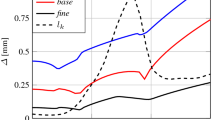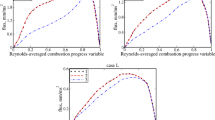Abstract
The classical “fast chemistry” analysis by Damköhler remains a common basis for calculation methods aimed at turbulent reacting flows. Perturbation approaches can be used to introduce finite rate chemistry effects, particularly where a distinct chemical time-scale separation is present, though more comprehensive techniques, e.g. based on a transported joint probability density function (JPDF), are typically required. Potential difficulties with the JPDF technique include issues related to the intrinsic structure of turbulent flames, particularly at low Reynolds numbers, and models for molecular mixing. The ability to predict the formation of NO is particularly interesting in this context given the strong sensitivity to chemical kinetic and non-adiabatic effects. The current work initially provides an assessment of uncertainties in the formation chemistry of NO in the context of new quantitative measurements, obtained in non-premixed laminar methane/air counterflow flames using ps-LIF, and subsequently explores how these translate to turbulent flames. A consistent systematically reduced (16 independent, 4 dependent and 28 steady state scalars) reaction mechanism is applied to model the turbulent flames of Barlow and co-workers (8200 ≤Re≤ 44000). The highest Re number flame additionally permits an investigation into the ability of the transported JPDF technique to deal with emissions of nitric oxide in flames close to global extinction. The work shows that the technique has the potential to reproduce NO levels and conditional PDFs under conditions with significant local extinction/re-ignition to within the uncertainties associated with the principal elementary reaction steps.
Similar content being viewed by others
References
Barlow, R., www.ca.sandia.gov/TNF, (2000).
Barlow, R. and Frank, J., Effects of turbulence on species mass fractions in methane/air jet flames. In: Proceedings Combustion Institute,Vol. 27 (1998) pp. 1087-1095.
Barlow, R., Karpetis, A., Frank, J. and Chen, J.-Y., Scalar profiles and NO formation in laminar opposed-flow partially premixed methane/air flames. Combust. Flame 127 (2001) 2102-2118.
Berg, P., Smith, G., Jeffries, J. and Crosley, D., Nitric oxide formation and reburn in low-pressure methane flames. In: Proceedings Combustion Institute,Vol. 27 (1998) pp. 1377-1384.
Brockhinke, A., Bülter, A., Rolon, J. and Kohse-HÖinghaus, K., Ps-LIF measurements of minor species concentrations in a counterflow diffusion flame interacting with a vortex. Appl. Phys. B 72 (2001) 491-496.
Carter, C. and Barlow, R., Simultaneous measurements of NO, OH and the major species in turbulent flames. Opt. Lett. 19 (1994) 299-301.
Coelho, P. and Peters, N., Unsteady modelling of piloted methane/air jet flame based on the eulerian particle flamelet model. Combust. Flame 124 (2001) 444-465.
Coelho, P., Teerling, J. and Roekaerts, D., Spectral radiative effects and turbulence/radiation interaction in a non-luminous turbulent jet diffusion flame. Combust. Flame 133(1) (2003) 75-91.
Daily, J., Laser induced fluorescence spectroscopy in flames. Prog. Energy Combust. Sci. 23 (1997) 133-199.
Daly, B. and Harlow, F., Transport equations in turbulence. Phys. Fluids 13 (1970) 2634-2649.
Dean, A., Hanson, R. and Bowman, C., High temperature shock tube study of reactions of CH and C-Atoms with N2. In: Proceedings Combustion Institute,Vol. 23 (1991) pp. 259-265.
Driscoll, J., Sick, V., Farrow, R. and Schrader, P., Measurements of NO distributions and fluores-cence lifetimes in a non-premixed counterflow CH4/air flame using picosecond time-resolved laser-induced fluorescense. In: Proceedings Combustion Institute,Vol. 29 (2002) pp. 2719-2726.
Evertsen, R., van Oijen, J., Hermanns, R., de Goey, L. and ter Meulen, J., Measurements of abso-lute concentrations of CHin a premixed atmospheric flat flame by cavity ringdown spectroscopy. Combust. Flame 132(1) (2003) 34-42.
Frank, J., Barlow, R. and Lundquist, C., Radiation and nitric oxide formation in turbulent non-premixed jet flames. In: Proceedings Combustion Institute,Vol. 28 (2000) pp. 447-454.
Frenklach, M., Wang, H., Goldenberg, M., Smith, G., Golden, D., Bowman, C., Hanson, R., Gardiner, W. and Lissianski, V., GRI Mech 2.11. Report GRI-95/0058, Gas Research Institute Topical Report (1995).
Grosshandler, W., RADCAL: A Narrow-Band Model for Radiation Calculations in a Combus-tion Environment. NIST Technical Note 1402 (1993).
H° ulek, T. and Lindstedt, R., Joint scalar-velocity PDF modelling of finite rate chemistry in a scalar mixing layer. Combust. Sci. Technol. 136(1-6) (1998) 303-331.
Janicka, J., Kolbe, W. and Kollmann, W., Closure of the transport equation for the probability density function of scalar fields. J. Non-equilib. Thermodyn. 4(1) (1979) 47-66.
Jones, W., Turbulence modelling and numerical solution methods for variable density and com-busting flows. Turbulent Reacting Flows. Academic Press, Chapt. 6 (1993) 309-374.
Juchmann, W., Latzel, H., Shin, D., Peiter, G., Dreier, T., Volpp, H., Wolfrum, J., Lindstedt, R.P. and Leung, K.M., Absolute radical concentration measurements and modelling of low-pressure CH4/O2/NO flames. In: Proceedings Combustion Institute,Vol. 27 (1998) pp. 469-476.
Lindackers, D., Burmeister, M. and Roth, P., Perturbation studies of high temperature C and CH reactions with N2 and NO. In: Proceedings Combustion Institute,Vol. 23 (1991) pp. 251-257.
Lindstedt, R., Lockwood, F. and Selim, M., A detailed kinetic study of ammonia oxidation. Combust. Sci. Technol. 108 (1995) 231-254.
Lindstedt, R., Louloudi, S. and Váos, E., Joint scalar probability density function modelling of pollutant formation in piloted turbulent jet diffusion flames with comprehensive chemistry. In: Proceedings Combustion Institute,Vol. 28 (2000) pp. 149-156.
Markus, M., Roth, P. and Just, T., A shock tube study of the reactions of CH with CO2 and H2O. Int. J. Chem. Kinet. 28 (1996) 171.
Mercier, X., Pillier, L., Bakali, A.E., Carlier, M., Pauwels, J.-F. and Desgroux, P., NO reburning study based on species quantification obtained by coupling LIF and cavity ring-down spec-troscopy. Faraday Discuss. 119 (2001) 305-319.
Miller, J. and Bowman, C., Mechanism and modeling of nitrogen chemistry in combustion. Prog. Energy Combust. Sci. 15 (1989) 287-338.
Miller, J. and Walch, S., Prompt NO: Theoretical prediction of the high-temperature rate coef-ficient for CH +N2 =HCN +N. Int. J. Chem. Kinet. 29 (1997) 253-259.
Paul, P., Gray, J., Durant, J. and Thoman, J., Collisional electronic quenching rates for NO A(2) ( +)( =0). Chem. Phys. Lett. 259 (1996) 508-514.
Paul, P., Gray, J., Durant, J. and Thoman, J., Collisional quenching corrections for laser-induced fluorescence measurements of NO A(2) +. AIAA J. 32 (1996) 1670-1675.
Pitsch, H. and Steiner, H., Large-eddy simulation of a turbulent piloted methane/air diffusion flame (Sandia Flame D). Phys. Fluids 12(10) (2000) 2541-2554.
Renfro, M., Klassen, M., King, G. and Laurendeau, N., Time-series measurements of CH concentration in turbulent CH4 air diffusion flames by use of picosecond time-resolved laser-induced fluorescence. Opt. Lett. 22 (1997) 175-177.
Roomina, M. and Bilger, R., Conditional moment closure (CMC) predictions of a turbulent methane-air jet flame. Combust. Flame 125 (2001) 1176-1195.
Schwarzwald, R., Monkhouse, P. and Wolfrum, J., Fluorescence lifetimes for nitric oxide in atmospheric pressure flames using picosecond excitation. Chem. Phys. Lett. 158 (1989) 60-64.
Shin, D., Dreier, T. and Wolfrum, J. Spatially resolved absolute concentration of fluorescence-lifetime determination of H2CO in atmospheric-pressure CH4 air flames. Appl. Phys. B 72 (2001) 257-261.
Sick, V., Hildenbrand, F. and Lindstedt, R., Quantitative laser-based measurements and detailed chemical kinetic modelling of nitric oxide concentrations in methane-air counterflow diffusion flames. In: Proceedings Combustion Institute,Vol. 27 (1998) pp. 1401-1409.
Speziale, C., Sarkar, S. and Gatski, T., Modelling the pressure-strain correlation of turbulence: An invariant dynamical systems approach. J. Fluid Mech. 227 (1991) 245-272.
Tamura, M., Berg, P., Harrington, J., Luque, J., Jeffries, J., Smith, G. and Crosley, D., Collisional quenching of CH(A), OH(A), and NO(A) in low-pressure hydrocarbon flames. Combust. Flame 144 (1998) 502-514.
Tang, Q., Xu, J. and Pope, S., PDF Calculations of local extinction and NO production in piloted-jet turbulent methane/air flames. In: Proceedings Combustion Institute,Vol. 28 (2000) pp. 133-139.
Tsujishita, M. and Hirano, A., Two-dimensional quenching lifetime measurements of OH: A(2) ( +)(v =1) and NO: A(2) ( +)(v =0) in atmospheric pressure flames. Appl. Phys. B. 62 (1996) 255-262.
Yaney, P., Kliner, D., Schrader, P. and Farrow, R., Distributed feedback dye laser for picosecond ultraviolet and visible spectroscopy. Rev. Sci. Instrum. 71 (2000) 1296-1305.
Zabarnick, S., Fleming, J. and Lin, M., Temperature dependence of CH radical reactions with H2O and CH2O. In: Proceedings Combustion Institute,Vol. 21 (1986) pp. 713-719.
Author information
Authors and Affiliations
Corresponding author
Rights and permissions
About this article
Cite this article
Lindstedt, R., Louloudi, S., Driscoll, J. et al. Finite Rate Chemistry Effects in Turbulent Reacting Flows. Flow, Turbulence and Combustion 72, 407–426 (2004). https://doi.org/10.1023/B:APPL.0000044403.72514.27
Issue Date:
DOI: https://doi.org/10.1023/B:APPL.0000044403.72514.27




